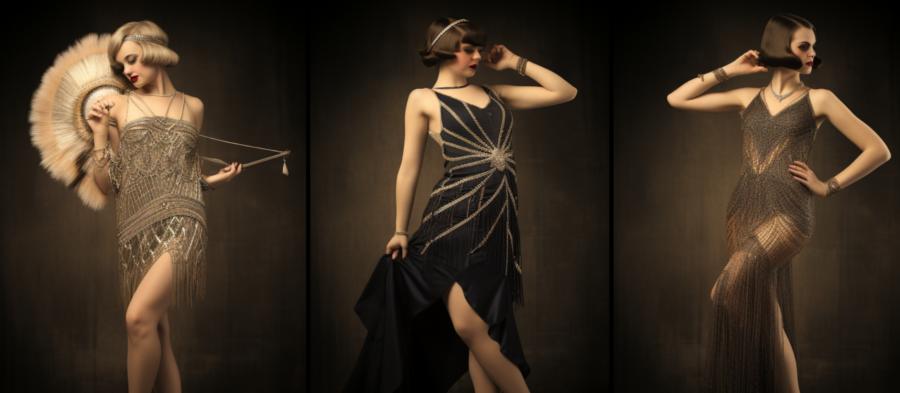Charleston and Flappers: 1920s Chicago's Dance Wardrobe Extravaganza

A Little Background on the Roaring Twenties
Picture this: the year is 1925, and you've just stepped foot into a dimly lit speakeasy in the heart of Chicago. You give the secret password to the burly bouncer, and as the door creaks open, a wave of jazz music washes over you like a tidal wave of sonic splendor. Welcome to the Roaring Twenties, my friend!Amidst the chaotic Prohibition era, a new generation of spirited young men and women sought a means of self-expression, freedom, and excitement. Thus, the flapper and Charleston dance craze were born. Strap in, because we're about to take a whirlwind tour of 1920s Chicago's dance wardrobe phenomenon, and we promise it'll be nothing short of a hoot!
Flappers: The Femme Fatales of the Dance Floor
Flappers, those vivacious and daring young women who dared to challenge societal norms, were the embodiment of the Roaring Twenties. With their short bobbed hair, knee-length dresses adorned with fringe and beads, and a penchant for cigarettes and alcohol, flappers were the It Girls of the decade.These ladies were not content with sitting on the sidelines, oh no. They took to the dance floor with gusto, gyrating and shimmying to the captivating melodies of jazz, and capturing the attention of all who laid eyes upon them.
Let's take a moment to appreciate the various sartorial choices that went into creating the quintessential flapper outfit:
- The Dress: Fringe, beads, and sequins were all the rage. The more movement and sparkle, the better!
- Headwear: The close-fitting cloche hat or a stylish headband with a feather or jewel accent were the perfect finishing touch.
- Accessories: Long strings of pearls, cigarette holders, and a flask concealed within a garter belt were all essential items for the fashionable flapper.
The Charleston: A Dance That Defined a Decade
Now that we've covered the flappers, let's delve into the dance that swept the nation: the Charleston. Energetic, lively, and highly syncopated, the Charleston was the ideal dance for the flapper generation, who were all about having a rip-roaring good time.Originating in African American communities in the early 1920s, the Charleston quickly gained popularity across the United States. In no time, Chicago's speakeasies were teeming with dancers kicking up their heels and swinging their arms with reckless abandon.
The Charleston was not for the faint of heart, nor the feeble of limb. With its high-energy moves and fast-paced rhythm, only the fittest and most daring dancers dared to attempt it. This, of course, made mastering the Charleston a badge of honor in the flapper community.
Chicago's Speakeasies: The Birthplace of the Flapper and Charleston Craze
While the Charleston and flappers could be found in cities across the United States, it was in the dark corners of Chicago's speakeasies where they truly flourished. At a time when alcohol was illegal and the city was ruled by notorious gangsters like Al Capone, speakeasies served as a sanctuary for those seeking refuge from the harsh realities of life.Within these clandestine establishments, flappers and Charleston enthusiasts could let loose, sip on bootlegged hooch, and dance the night away without fear of judgment or reproach. In many ways, Chicago's speakeasies were the birthplace of the flapper and Charleston craze, providing a space for these rebellious individuals to express themselves freely and without inhibition.
A Lasting Legacy: The Influence of Flappers and the Charleston on Modern Culture
Fast forward to today, and the impact of flappers and the Charleston on our modern culture is undeniable. From popular movies like The Great Gatsby and Chicago to the resurgence of prohibition-style bars and speakeasies, it's clear that the allure of the Roaring Twenties is alive and well.In terms of fashion, the flapper aesthetic has left an indelible mark, with fringe, sequins, and headbands making regular appearances on runways and red carpets. And let's not forget the iconic bob haircut, which has been sported by countless celebrities and fashion icons over the years.
As for the Charleston, its influence can be seen in various dance styles, including swing and Lindy Hop, as well as in the continued popularity of jazz music. Indeed, the Charleston remains a popular choice for choreographers and dancers, who continue to be captivated by its infectious energy and lively spirit.
So there you have it, a whirlwind tour of Charleston and Flappers: 1920s Chicago's Dance Wardrobe. While the Roaring Twenties may be long gone, the enduring impact of the flappers and Charleston on our modern culture is a testament to the power of self-expression, freedom, and a darn good time.
Article kindly provided by foreverinfashion.org
Latest Articles
- The Psychology of Tattoo Aesthetics: Why Certain Imagery Resonates
- Style That Works With Your Body, Not Against It
- Fashion Tourism on Wheels: Curated Shopping Routes Led by Chauffeur Guides
- The Charm of Certainty in a World of Indecision
- Can an Everyday T-Shirt Be Turned into a Modern Heirloom?
- Color, Ceremony, and the Psychology of Celebration
- Styling Graphic T-Shirts for Different Body Types
- Getting Kids to Wear Their Hats Without a Bribe or a Meltdown
- Mastering the Art of Being the Unnoticed Photographer
- Quiet Sportswear Moves Loudly
- Fashion's Most Misunderstood Color Is Brown
- Weight Matters When Cotton Gets Real
- SKU's Out for Summer: Why Your Warehouse Is Melting Down
- Ink as Accessory - How Tattoos Are Replacing Jewelry in Modern Style
- Accessories
- Jewellery
- Footwear
- Skirts and Dresses
- Shirts and Blouses
- Beauty and Makeup
- Fashion Photography
- Sustainable Fashion
- Street Style
- Fashion History
- Fashion Business
- Fashion Styling
- Fashion Events
- Plus-Size Fashion
- Men's Fashion
- Women's Fashion
- Fashion Blogging
- Fashion Trends
- Fashion Retailers
- Fashion Tips and Advice
- Fashion Business Startups
- Fashion Around the World
- Lingerie
- Sportswear
- Weddings

